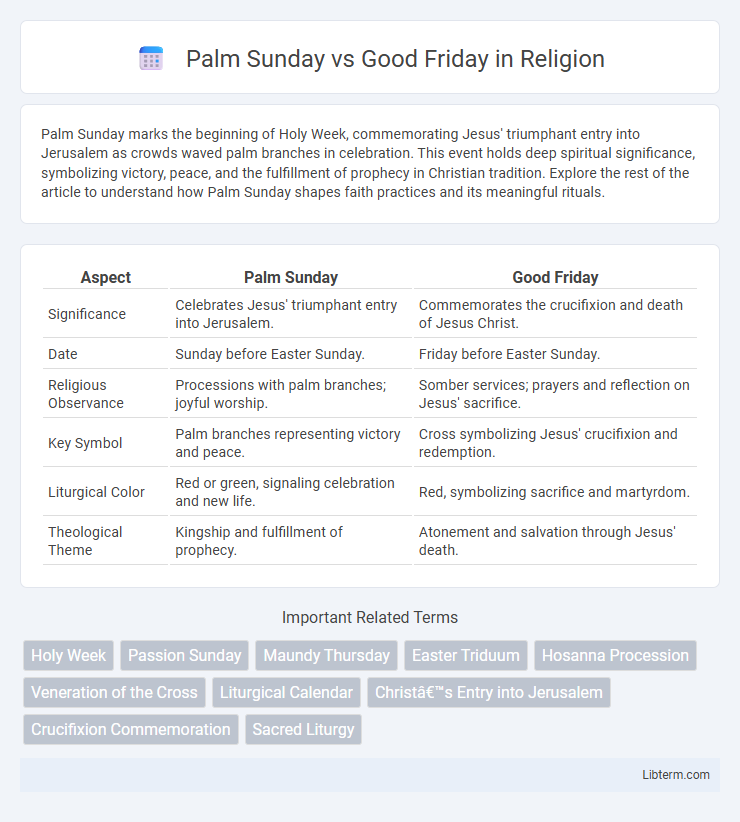Palm Sunday marks the beginning of Holy Week, commemorating Jesus' triumphant entry into Jerusalem as crowds waved palm branches in celebration. This event holds deep spiritual significance, symbolizing victory, peace, and the fulfillment of prophecy in Christian tradition. Explore the rest of the article to understand how Palm Sunday shapes faith practices and its meaningful rituals.
Table of Comparison
| Aspect | Palm Sunday | Good Friday |
|---|---|---|
| Significance | Celebrates Jesus' triumphant entry into Jerusalem. | Commemorates the crucifixion and death of Jesus Christ. |
| Date | Sunday before Easter Sunday. | Friday before Easter Sunday. |
| Religious Observance | Processions with palm branches; joyful worship. | Somber services; prayers and reflection on Jesus' sacrifice. |
| Key Symbol | Palm branches representing victory and peace. | Cross symbolizing Jesus' crucifixion and redemption. |
| Liturgical Color | Red or green, signaling celebration and new life. | Red, symbolizing sacrifice and martyrdom. |
| Theological Theme | Kingship and fulfillment of prophecy. | Atonement and salvation through Jesus' death. |
Introduction to Palm Sunday and Good Friday
Palm Sunday commemorates Jesus Christ's triumphant entry into Jerusalem, marked by the waving of palm branches and joyful crowds, symbolizing hope and the fulfillment of prophecy. Good Friday solemnly observes the crucifixion and death of Jesus, reflecting on sacrifice, suffering, and redemption within Christian tradition. These events anchor Holy Week, contrasting celebration with mourning and highlighting the core themes of Christian faith.
Historical Background of Palm Sunday
Palm Sunday commemorates Jesus Christ's triumphant entry into Jerusalem, an event recorded in the Gospels that marks the beginning of Holy Week leading to Easter. Historically, it symbolizes the fulfillment of the Old Testament prophecy found in Zechariah 9:9, where the Messiah arrives riding a donkey. This day reflects themes of peace and kingship, contrasting with Good Friday, which observes Jesus' crucifixion and sacrifice for humanity's sins.
Historical Significance of Good Friday
Good Friday commemorates the crucifixion of Jesus Christ and his death at Calvary, marking a pivotal event in Christian theology representing sacrifice and redemption. Historically, it is observed during Holy Week on the Friday preceding Easter Sunday, emphasizing Jesus' suffering and the fulfillment of Old Testament prophecies. This solemn day has inspired diverse liturgical traditions and reflections on the themes of atonement and salvation across various Christian denominations.
Key Differences Between Palm Sunday and Good Friday
Palm Sunday marks Jesus' triumphant entry into Jerusalem, symbolizing celebration and hope, while Good Friday commemorates His crucifixion, representing sacrifice and sorrow. Palm Sunday involves the waving of palm branches and joyous crowds, contrasting with Good Friday's solemn remembrance and reflection on Jesus' suffering. Theologically, Palm Sunday emphasizes Jesus as the Messiah and King, whereas Good Friday focuses on His atoning death for humanity's sins.
Symbolism and Traditions of Palm Sunday
Palm Sunday symbolizes Jesus' triumphant entry into Jerusalem, marked by the waving of palm branches, which represent victory and peace in Christian tradition. This event initiates Holy Week and is commemorated by processions and the blessing of palms in many churches worldwide. The palm branches are often kept by believers as sacramentals, symbolizing faith, renewal, and the anticipation of Jesus' resurrection.
Symbolism and Observances of Good Friday
Good Friday symbolizes the crucifixion and suffering of Jesus Christ, marked by somber observances such as fasting, prayer, and reflective church services. The day's rituals emphasize repentance and the sacrifice made for humanity's redemption, including reenactments of the Passion and the veneration of the cross. Observances often include silent processions, the Stations of the Cross, and moments of meditation on themes of forgiveness and salvation.
Scriptural Accounts: Palm Sunday vs Good Friday
Palm Sunday marks Jesus' triumphant entry into Jerusalem, as described in Matthew 21:1-11, where crowds wave palm branches and proclaim Him the Messiah. Good Friday records Jesus' crucifixion, with accounts in John 19:16-37 detailing His suffering, death, and the significance of the atonement. Both events fulfill Old Testament prophecies and are pivotal in the Passion narrative, highlighting Jesus' kingship and sacrificial role.
Liturgical Practices on Palm Sunday and Good Friday
Palm Sunday liturgical practices emphasize the blessing and distribution of palm branches, commemorating Jesus' triumphant entry into Jerusalem, followed by processions and the reading of the Passion narrative. Good Friday ceremonies focus on solemn liturgies marked by the Veneration of the Cross, the reading of the Passion account, and prayers for the Church and the world, highlighting Christ's crucifixion and sacrifice. Both days incorporate distinct rituals that underline key events in Holy Week, with Palm Sunday initiating the commemoration and Good Friday reflecting somber reflection and mourning.
Theological Importance in Christian Faith
Palm Sunday marks Jesus Christ's triumphant entry into Jerusalem, symbolizing messianic fulfillment and the inauguration of his passion, central to Christian soteriology. Good Friday commemorates the crucifixion and death of Jesus, representing the ultimate sacrifice for humanity's sins and the foundation of redemption doctrine. Both events are pivotal in Christian theology, emphasizing the paradox of kingship through suffering and the hope of resurrection.
Contemporary Celebrations and Reflections
Palm Sunday features vibrant processions with palm branches symbolizing Jesus' triumphant entry into Jerusalem, emphasizing themes of hope and renewal in contemporary Christian worship. Good Friday ceremonies are marked by solemn services, including the Stations of the Cross and meditative prayers, reflecting on Jesus' crucifixion and sacrificial love. Both observances invite believers to engage deeply with the Passion narrative, blending ancient rituals with modern expressions of faith and community solidarity.
Palm Sunday Infographic

 libterm.com
libterm.com